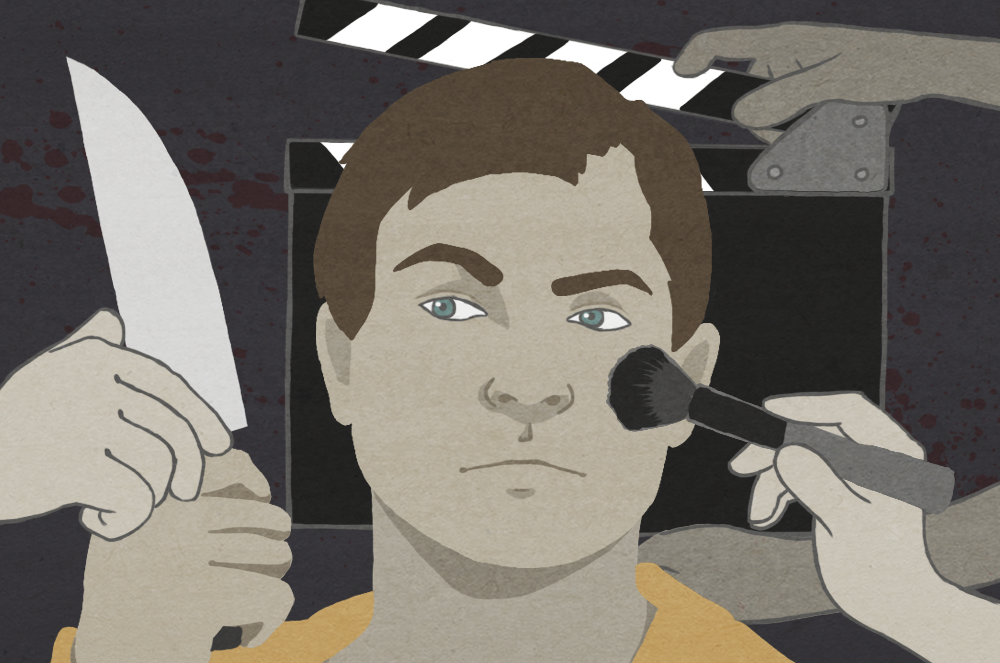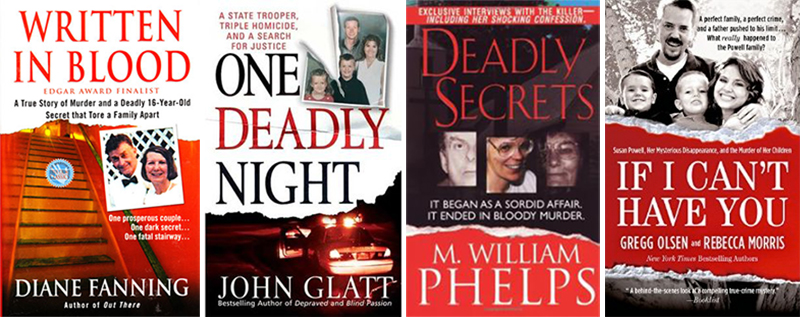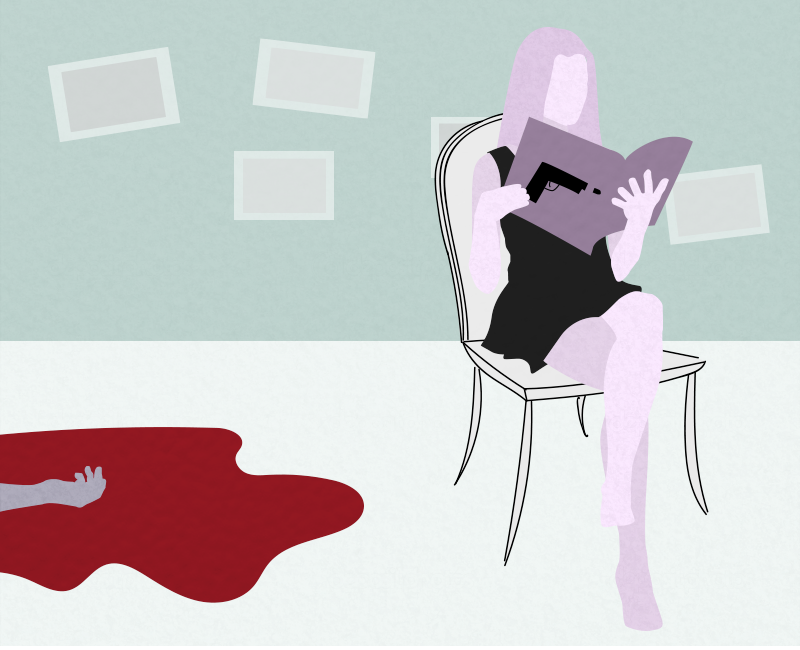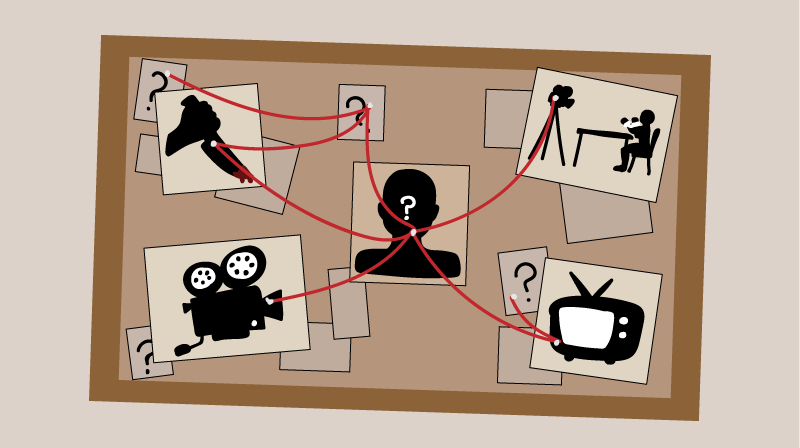Book-ended by two heavy-hitting true crime series, The Jinx and Making a Murderer, 2015 (and ’16) saw a lot of journalists grappling with the draw of these programs and true crime as a genre. These documentaries were cinematic, following those accused of crimes but with hazy details that either led to them being imprisoned possibly wrongly (Steven Avery) or free (Robert Durst). There is an ambiguity with these real-life narratives that allows filmmakers to create engaging documentaries that grapple with inconsistencies, problematic ideologies, and injustices. Both series quickly became rulers for filmmakers as more highbrow-aesthetic true crime films are showing up on Netflix and HBO.
Many credit the Sarah Koenig’s Serial podcast with the “resurgence” of the true crime interest. Her coverage of Adnan Syad’s case riveted many, myself included, by getting into the weeds regarding their youth, religious and cultural differences, and hindsight. Her investigation was frustrating and compelling. Whether or not that podcast directly influenced the production of The Jinx and Making a Murderer, its popularity no doubt helped the distribution of both. They were just similar enough, exploring a subject and their bizarre relationship to the legal system. Steven Avery’s wrongful incarceration and subsequent murder arrest elicited a similar sense of empathy and frustration as Serial. Robert Durst, on the other hand, was an oddity, with production attempting all they could to convince him to admit guilt. Both were compelling and at times problematic, but they were able to do something so rare in today’s media market — become water cooler conversation.
Stephanie Merry for The Washington Post wrote, “True crime shows are suddenly dominating every conversation. Is he guilty? Is he innocent? Everyone has a theory.” Writers from Jezebel, Slate, New York Magazine, and The Economist began to realize that women in particular invested a lot of time and energy in these programs and crime in general — and they began to question why? Why are women, who represent such a small segment of violent criminals, interested in all this murder?
But my question became, “journalists, where have y’all been?”
ID on Discovery has provided a constant stream of true crime, with original content and refurbished Datelines and Forensic Files since 2006. Oxygen’s Snapped is in its 19th season (starting in 2004). And Dateline, 20/20, Unsolved Mysteries, Cops, and America’s Most Wanted demonstrate true crime’s continued presence on American television, regardless of technological developments, cable expansions, and shifting expectations for television’s content quality.
And though my experience can’t speak to everybody’s, I know I am unlikely to be the only one who grew up with a mother buying cheap mass-market paperbacks with terrible pseudo-Gothic fonts and with covers inevitably featuring something torn — court documents, family photos — ruptures that signified breaks with societal codes of conduct. They featured a few inky pages in the middle with more photographs of the victims and killers, coupled with the murder scenes, which were perfect for an inquisitive six-year-old like myself.
Also, did these journalists miss John Waters’s 1994 film Serial Mom, which had explored the cultish fascination women had for crime — their time and money invested in purchasing mementos and nods? Or to go back further, the pulp magazines and paperbacks of the early 20th century that moms could pick up at the grocery store. And we could no doubt go back even further to the early Hollywood scandals involving high profile (alleged and not-so-alleged) murders and deaths which prompted the industry’s move toward self-censorship. And we can no doubt track the journalism covering executions and crime beats. And most of those following these developments, interacting with the news, and circulating information have been women. The demographics for readership and viewership have consistently been women.
This surprise, then, regarding women’s interest appears to be an implicit gendering — by being surprised when the demographics don’t fit your expectations despite the demographic consistently expressing interest. When Jezebel asks, “Why Are Women Obsessed with Investigation Discovery’s Grisly TV Shows?” it begs the question: Why wouldn’t they be when they have been consistent consumers of true crime throughout the 20th century?
True crime is a genre that seems to have rested under the surface until texts that looked more cinematic and apparently more complex came into the picture. There seems to be a line drawn between quality and exploitation, with the latter being considered “women’s texts” with their nods toward soap operas and gossip. Regardless of form, they both deliver the content and do so questionably and in a way that urges feeling. We can discuss aesthetic, but in the cases of The Jinx and Making a Murderer, the drive to produce emotional responses from their viewers mean the same manipulative tactics of exploitation film, just nicer looking. Both incorporate the same data/facts, both employ the same types of interviews with the same people involved (directly or tangentially). Perhaps ironically, these exploitative true crime programs are also more inclined to highlight and justify women’s aggression, whereas quality films about women accused of murder tend not to detract from stereotypes regarding victimhood. The rhetorical strategies are different, with quality narratives (think The Jinx and Making a Murderer) encouraging surveillance and investigation whereas lower forms (ID on Discovery’s lineup) privilege surveillance and gossip, which is used in such a way as to synthesize and pass information along through methods that run concurrent to “facts” from courts and media.
What is considered more “exploitative” — with snarky titles like A Crime to Remember, Death By Gossip, Momsters, Married with Secrets, Murder Among Friends, Murder U, Web of Lies, Who the (Bleep) Did I Marry?, Wives with Knives — is in essence a little more earnest in the goal of selling these narratives to the viewership. Whereas The Jinx and Making a Murderer rely on the visual language to offer a host of possibilities for audiences to unpack, the use of techniques like voice overs guide the viewers into understanding the plots and “cast.” The scare quotes are a tongue-in-cheek way to acknowledge the problematic nature of evaluating these stories as narratives with form, as forms of entertainment that deal with the very real traumas of these crimes. Regardless of production values, this oddity of utilizing the real tragedies and making them entertaining and bingeable bring up a host of ethical quandaries.
And those questions also relate to representation. There have only been ten women on the FBI’s Most Wanted List. And as much as I am not advocating for murder — we can’t even make this list? Women seem forever in limbo between the prestigious points of good and evil. Yet, as of this essay’s writing, there are more than 50 women on death row, many of them convicted of killing their children or husbands. As of 2012, there were more than 5,000 women serving life sentences and 300 of those are serving those sentences without the possibility of parole. Yet, those that seek to use cinema as a means to elaborate on the criminal justice system and policing nearly always utilize male narratives to so. There are narratives about women; however, those documentaries are more often focused on the tawdry details of their crimes, contain examinations of how they could possibly commit those crimes, and seek to elicit emotional responses from viewers, as opposed to action. I think both “quality” and “low-brow” forms are useful, and I’ll talk a bit more about why watching Deadly Women and Snapped can be so fulfilling. There is no doubt that programs like The Jinx and Making a Murderer are doing something different, and by bringing documentaries further into the public’s consciousness, but in doing so they eclipse forms of docu-enterainment that document women’s transgressions, refusals, breaks from social norms — so radically that they commit acts of violence and even murder. These shows provide spaces for women to exercise fantasies not as investigators (which seems to be the priorities of long-form dramas obsessed with methodology and evidence) but as murderers.
True crime is a beast to unpack — as a concept, it spans literature, journalism (including podcasts), and film. It is also adaptable across these formats — fictionalized representations on TV’s Law and Order, films like Richard Linklater’s hybrid Bernie and Jarecki’s Jinx precursor, All Good Things, and mob staples like Goodfellas, complicate how we can easily discuss true crime as a genre, given the range of its forms. Mark Seltzer’s elevator thesis is that “true crime is crime fact that looks like crime fiction.” Structurally, it is a narrative that perverts the concept of “everyday” — regardless of form, the concepts of “normal days,” “normal marriages,” “normal families” are quickly uprooted, providing a rupture (or, as Seltzer continues, some wounds) to provide (dare I say) allowances for fantasy and pleasure. Not necessarily pleasure in the murder, but a flirtation with abnormality and adventure.
How that abnormal normal is represented becomes a bit more complex and leaves a lot of questions — is it fair to compare documentary films made to be consumed in one sitting to those made episodically with the option to binge? Or long form to short form? Or documentaries made to include commercials?
I think Stella Bruzzi makes compelling arguments as to how and why we can place these films in conversation with each other as belonging to the genre while acknowledging differences in form and tone, needs and reception. Bruzzi argues that the genre’s major concern is the concept of “TRUTH,” the fact that true crime is concerned with evidence and can include threads of dialogue unacceptable in court cases like hearsay and rumor. True crime, regardless of format, is also concerned with the fluidity of truth — either explicitly to expose or through presenting ambiguity and allowing audiences to waffle back and forth, discovering their own truth. And this search is found through the use of interviews with an array of people related to the event, the examination of documents, and re-creations.
Both high- and low-brow documentaries feature the same elements, but I think the difference between these quality narratives and exploitative ones is the method of storytelling and, primarily, the use of voice-over and the incorporation of cinematic techniques (which don’t tend to be necessarily the art itself as much as the financial possibilities — Deadly Women can only do so much with their wig budget). The voice-over allows for a different tone — one which invites the audience into the world and guides their perspective. It’s not so much about the audience solving the crime as much as it is about listening to somebody say, “Girl, do I have a story for you . . .” about people committing violent acts against men, women, and sometimes children.
To help illustrate, I wanted to get into the opening credits, because — funnily enough — the aspects of absence and presence take place even there as means of setting the stage and establishing expectations. There is a spectrum, with Making a Murderer relying mostly on absence and Deadly Women full of presence. The montage sequence used to introduce and prepare viewers rests primarily on the visual imagery. The music sounds like a slowly moving train, trudging through mud as these hazy images of the landscape (Manitowic County, Wisconsin) and symbols from the narrative, like knives, the crime scene, and the alleged murderer Steven Avery, are cobbled together to provide a sense of uneasiness. There is nothing grounding us, nothing truly telling of the narrative — instead, the labor is on us as we are forced to try to build our own narrative from the pieces. And that is very much how the documentary plays out, with talking heads talking to each other, conversing with footage — in one episode, one can feel that Avery is without a doubt guilty and then be confronted with information in the next episode that discredits one’s theory.
The Jinx employs a similar montage of images, but the music, by The Eels, provides another layer of atmosphere. With the repeated masculine vocals reiterating “I need fresh blood,” the audience is cued into the filmmaker’s perspective — that the subject, Robert Durst, is undoubtedly guilty — a man who hates women and has murdered at least two. It is more difficult to stray from any readings of Durst being innocent, as the filmmakers seem to be looking for their Thin Blue Line moment throughout the narrative (which they end up finding just in time for the finale). There is still some wiggle room — some opportunities to read between the lies. If anything, Jarecki leaves a lot of room for one to want to read against his work out of spite.
But lower forms, derogatively labeled as Informative Murder Porn by South Park, leave very little to the imagination. There is little room to interact as the voice-over dictates the terms — that the people who will be discussed are either guilty or innocent. The goal for these programs is not necessarily for the audience to participate but to listen — to enjoy the process as opposed to reaching for solutions.
From absence to presence, these clips represent the range in which information is shared and how tone shapes the narrative. As a comedy scholar, I can’t help but to also note the ways in which humor is employed in that final clip — a way to lighten the mood, make it perhaps more entertaining and less factual, and in a way that simulates gossip. They use language and intonation to simulate the ways in which stories are told through nontraditional networks and outside of institutions with coded language, eyebrow raises, and wordplay. Narration is used as a means to enlist us as an ally or accomplice — to become part of the conspiracy. This is a tone we tend not to find in more “serious” and artistic work unless it is to note that there exists unsubstantiated gossip — but it is not necessarily relied upon or recreated as readily as in women’s programs.
While I see a trend toward quality narratives gravitating toward male protagonists — Brendan and Steven Avery, OJ Simpson, The West Memphis Three, and Robert Durst — there have been attempts to add complexity to women’s narratives. Yet, these films tend to employ the same tactics in their “lower forms.” When I saw the opening scenes of Amanda Knox, with her cats everywhere, the connections were made. Here is a wild and yet domesticated woman. When Nick Broomfield decides to get down and dirty in Aileen Wuornos’s background (and worm himself into the narrative), we observe the cultural obsession we have with women’s abuse and exploitation. BBC III’s miniseries featuring Emilia Carr is probably most like Making a Murderer, with its focus on class, but it is also an eight-part series of ten-minute segments, allowing very little detail to shape. In fact, these “quality” documentaries seem mostly to be an opportunity for women to sit in front of the camera and dispel the myths and rumors that surround their names — by involving the same tactics used to discredit them. And to specifically address the ways they have been maligned as unruly women. Essentially, talking more about the gossip than the crimes.
I also don’t think it’s a coincidence that when we’re talking about abnormalizing the normal, these shows on Oxygen and ID on Discovery feature, more often than not, female murderers — and while I wouldn’t call it a celebration, there does seem to be a thread regarding the pleasure in narratives that break from the norm. Many of these narratives revolve around women who have affairs, are sexually assertive, and are more than capable of organizing or committing murder — or that act aggressively when confronted with hard truths about infidelities or money problems — making moves to satisfy needs. And while in popular culture we expect a form of punishment for this behavior, the entertainment associated with these “lower forms” does not truly punish its subjects. Many of those featured, within the real world, are sentenced to jail or given the death penalty — but these narratives are presented in such a way as to explore the pleasure of others’ aggression — not to condone it, but to find pleasure in women’s aggression. Maud Lavin, in Push Comes to Shove, writes in the opening, “Aggression rolls through our bodies and our psyches. We can express it as a key ingredient of anger, of determination, of movement forward, of space clearing, of lust, of harm, of survival, of creation . . . Aggression is necessary, large, messy, psychological, and physical.” She argues that feminine aggression within popular culture is celebrated, and I think in the current political climate full of nasty women and raised fists, we can see a sort of reclamation of that anger and rage. I am concerned, however, that popularity of quality true crime will erase the other programs that rely on alternate information networks like gossip to tell their stories, will remove the elements that celebrate girl culture, and will dictate “correct” ways to tell and enjoy true crime. •
Images courtesy of Shannon Sands.








